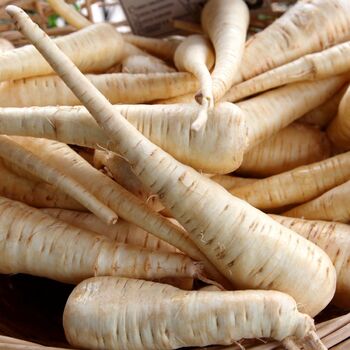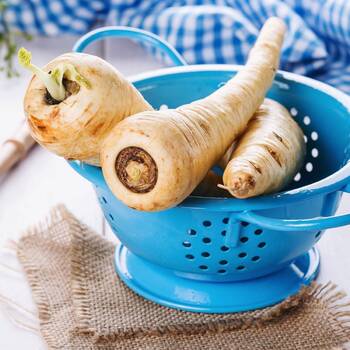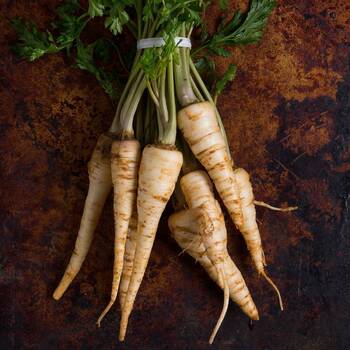
How to Grow Parsnip Seeds
Grow Guide #2300
Family: Apiaceae
Binomial name: Pastinaca sativa
Life Cycle: Biennial (but usually grown as an annual)
This 'How to Grow' guide details everything a home gardener needs to know to plant, grow and care for Parsnips (Pastinaca sativa).
When to Sow Parsnip Seeds
Parsnips can be grown year-round in most climates. Avoid planting in extremely hot or cold weather which can affect germination and growth. Use the table below to identify the best time of year to sow parsnips in your climate.
| JAN | FEB | MAR | APR | MAY | JUN | JUL | AUG | SEP | OCT | NOV | DEC | |
|---|---|---|---|---|---|---|---|---|---|---|---|---|
| Cool | ||||||||||||
| Temperate | ||||||||||||
| Sub-Tropical | ||||||||||||
| Tropical | ||||||||||||
| Arid |
Preparation
Parsnip plants are best grown in full sun or part shade. Choose a location that will receive at least 3 hours of full sun each day.
Parsnip plants need a loose, well drained soil enriched with organic matter. Prepare soil by weeding it thoroughly, digging it over to at least a spade’s depth to loosen the soil, and adding aged animal manure or compost. Organic matter can be dug into heavy soil to lighten it so roots can grow freely. Keep the area free of weeds until planting. Learn more about preparing soil for planting here.
How to Sow Parsnip Seeds
Parsnip seeds do not require any treatment (eg soaking, stratification) before sowing.
Parsnip seeds grow best when they are sown directly into the garden.
- Sow seeds directly in the garden 5mm deep and 5-10cm apart, with rows 35-50cm apart.
- Keep soil moist but never wet or dry.
- Seeds should germinate in around 14-28 days at a soil temperature of 10-21°C.
- Young seedlings will need protection from pests, pets and weather until they are established.
Tip: Seeds of this variety can be slow to germinate. Take note of the expected germination time, be patient and follow the recommended depth and temperature guidelines closely for the best chance of success.
How to Grow Parsnip
Parsnip plants may need watering during the growing season. Water when the soil is dry about 5cm below the surface (test this by scratching away a little soil with your finger). Water deeply in the early morning or late afternoon. Avoid watering the leaves of plants to avoid fungal diseases. Learn more about watering here.
Optional: To give plants room to grow, thin seedlings when they are large enough to handle. Pull out any weak or small seedlings so plants are spaced about 5-10cm apart.
If soil was well prepared no extra fertiliser should be necessary. Fertilising can result in excessive leaf growth at the expense of roots forming. In poor soil use a fertiliser low in nitrogen and high in phosphorus, such as blood and bone, applied at the recommended rate.
How to Harvest Parsnips
Parsnips should be ready to harvest in approximately 120-140 days.
Roots are ready to harvest when they are large enough to eat, and can be harvested as needed. Harvest individual roots by gently pulling at the base of the leaves, or use a garden fork to lift multiple roots from the soil. Shake off any excess soil and cut the foliage 1-2cm above the top of the root. Store parsnips in a perforated plastic bag in the fridge. For longer term storage parsnips can be blanched then frozen.
Common Problems when Growing Parsnips
Like all plants, parsnip is susceptible to some pests, diseases and other problems. Below is a list of the most common problems gardeners encounter when growing parsnip plants:
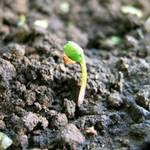 Poor germination may be caused by sowing old seed. Seed for this species does not store well long-term, so use fresh seed each year. Make a note of the sowing date and the expected germination time. Seeds may take longer than the expected time, especially if conditions such as soil temperature are not ideal.
Poor germination may be caused by sowing old seed. Seed for this species does not store well long-term, so use fresh seed each year. Make a note of the sowing date and the expected germination time. Seeds may take longer than the expected time, especially if conditions such as soil temperature are not ideal.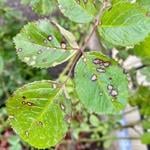 Bacterial leaf spot is a disease that causes irregularly shaped brown spots on all above-ground parts of a plant. The spots at first appear to be wet but become dry and scab-like over time. Leaves and flowers can fall prematurely. Water plants at soil level (not on the leaves), dispose of fallen leaves and fruit and practice crop rotation.
Bacterial leaf spot is a disease that causes irregularly shaped brown spots on all above-ground parts of a plant. The spots at first appear to be wet but become dry and scab-like over time. Leaves and flowers can fall prematurely. Water plants at soil level (not on the leaves), dispose of fallen leaves and fruit and practice crop rotation.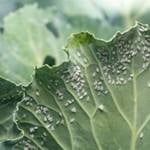 Whitefly is a sap-sucking insect related to aphids. They are often found in large numbers on the underside of leaves and will swarm in clouds when disturbed. Plants may have yellowing leaves or may wilt, and growth will be slowed. Whitefly can be removed with a garden hose or sprayed with soap spray. Badly affected plants should be destroyed. Attracting beneficial insects that will prey on whitefly can be beneficial. Read more about managing whitefly here.
Whitefly is a sap-sucking insect related to aphids. They are often found in large numbers on the underside of leaves and will swarm in clouds when disturbed. Plants may have yellowing leaves or may wilt, and growth will be slowed. Whitefly can be removed with a garden hose or sprayed with soap spray. Badly affected plants should be destroyed. Attracting beneficial insects that will prey on whitefly can be beneficial. Read more about managing whitefly here.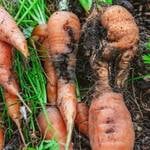 Carrot fly (Psila rosa) is a flying insect that lays its eggs in seedlings. When the larvae hatch they live in the soil and burrow into the roots to feed. Include companion plants in your garden or use insect exclusion netting over your crops to deter the pests.
Carrot fly (Psila rosa) is a flying insect that lays its eggs in seedlings. When the larvae hatch they live in the soil and burrow into the roots to feed. Include companion plants in your garden or use insect exclusion netting over your crops to deter the pests.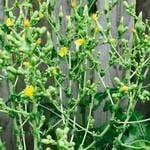 Bolting is when a plant prematurely flowers and goes to seed. Bolting can be caused by a period of extreme weather. Avoid sowing seed until after the danger of frosts has passed or in very hot weather. Water plants regularly and deeply in hot weather to prevent them suffering heat stress.
Bolting is when a plant prematurely flowers and goes to seed. Bolting can be caused by a period of extreme weather. Avoid sowing seed until after the danger of frosts has passed or in very hot weather. Water plants regularly and deeply in hot weather to prevent them suffering heat stress.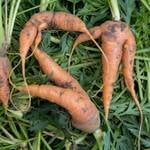 Forked roots are usually caused by stony or heavy soil such as clay. The roots cannot grow freely in the soil or hit rocks or other obstacles and split into two. Cultivate the soil well before planting, dig in some coarse sand or compost to lighten the soil, or grow round or short varieties suited to heavy soil.
Forked roots are usually caused by stony or heavy soil such as clay. The roots cannot grow freely in the soil or hit rocks or other obstacles and split into two. Cultivate the soil well before planting, dig in some coarse sand or compost to lighten the soil, or grow round or short varieties suited to heavy soil.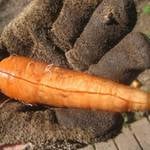 Split roots are usually caused by inconsistent watering when roots are mature. Water deeply and evenly to keep soil moisture consistent and always take recent or expected rainfall into consideration before watering.
Split roots are usually caused by inconsistent watering when roots are mature. Water deeply and evenly to keep soil moisture consistent and always take recent or expected rainfall into consideration before watering.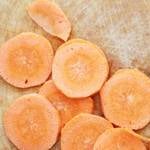 Tough roots usually indicate that the roots were harvested too late. Harvest roots when they are young and tender.
Tough roots usually indicate that the roots were harvested too late. Harvest roots when they are young and tender. Small roots can be the result of sowing too thickly or over fertilising. Thin seedlings to give roots adequate space to grow. Do not fertilise plants as this may encourage the growth of foliage at the expense of roots.
Small roots can be the result of sowing too thickly or over fertilising. Thin seedlings to give roots adequate space to grow. Do not fertilise plants as this may encourage the growth of foliage at the expense of roots.


.png)



